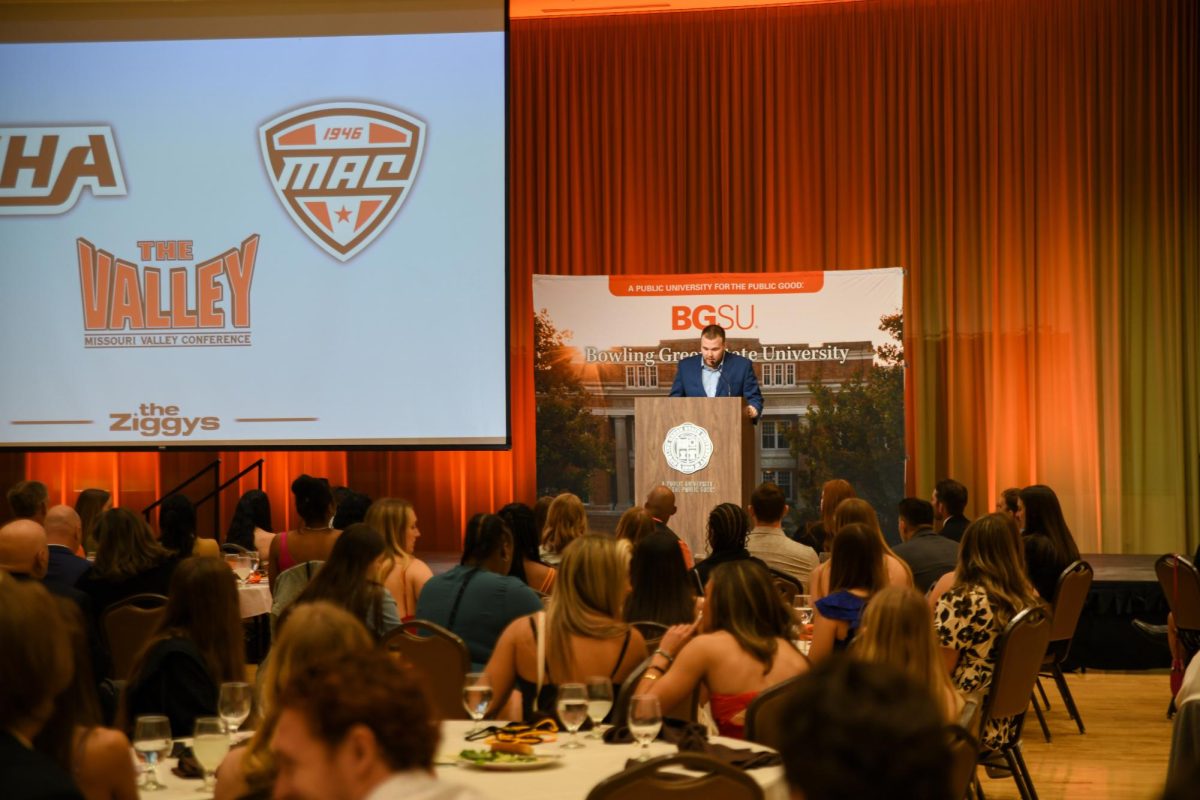On a warm June day in 1967, days after the new Jerome Library opened, it was already leaking.
On a warm April day nearly 40 years later, it still is.
A. Robert Rogers, the library’s director in the 1960s, sent a memo on June 26, 1967 detailing stains caused by dripping water.
The memo states, “Apparently, the trouble is caused by an overflow when the shrubs on the east side of the building are watered.”
Now, the building still leaks, but the reasons why are more complex.
A bucket sits in the southeast corner of Jerome’s first floor catching drips that fall from a brown spot in the ceiling.
Next to the drip’s source, ceiling panels are missing, revealing a system of pipes spaced 12 inches apart.
It’s the Kathabar system. While it once ran a lithium chloride solution to control humidity, warm water runs through it now.
The chemicals were shut off about 20 years ago, estimated Bob Waddle, assistant vice president at Capital Planning. While it’s unknown why the University shut off the system, its stoppage leaves the library without a way to control humidity.
“It helps to control the temperature, but the warm water doesn’t do a doggone thing for the humidity,” Waddle said.
The lack of humidity control comes at a cost. Extreme humidity can be damaging to papers and books, said Eric Honneffer, the document conservator at the library.
“We want to keep humidity under control because moisture is a catalyst for deterioration,” Honneffer said.
While books can adapt to sustained increases in humidity, wild swings up and down can be damaging. And the library’s humidity is erratic in months of extreme hot or cold, Honneffer said.
A 1964 memo from Rogers during the library’s planning stages describes “the ideal conditions for the preservation of books and user comfort” as 72 to 75 degrees and 35 to 40 percent relative humidity.
But there are actually large fluctuations in the library’s humidity, according to records kept by the archivists.
For example, at the beginning of last October, the humidity was 69 percent. By the end of the month, it was 31 percent.
One of the highest recorded humidities was last July – 72 percent on July 25.
But during December, January and February, the library is usually between 25 and 40 percent humidity.
More problems
Leakage isn’t the library’s only structural problem – the books are getting dirty too.
On Jerome’s fifth floor, where the Center for Archival Collections is, Honneffer has taped homemade fabric filters over all the ceiling vents.
“We put these up not only to protect ourselves and to keep the black dust out of our hair, but to keep debris off the books,” he said. “We don’t want debris on the collections.”
While Honneffer couldn’t remember exactly when he put up the filters, he estimated it might have been as long as three years ago.
In that time, the white filters have turned dark gray, stained by particles that have blown out of the vents.
It’s normal for some particles to float through the air, according to Chris Keil, an associate professor of environmental health who specializes in indoor pollution.
“If things aren’t cleaned regularly, you’d expect a buildup,” Keil said. “If it hasn’t been done for a year, it may be unsightly but it’s typical.”
But on the library’s first floor, where many vents don’t have filters over them, more than dust sits on the books. Black, granular debris can be found on the top shelves of the stacks on Jerome’s east side.
Help isn’t on the way
Fixing all these problems wouldn’t be cheap. It could cost an estimated $15 million in renovations to stop the plumbing, climate and ventilation problems.
There’s no immediate plan to raise that much money. It’s been four years since the University received the multi-million dollar estimate from a Toledo-based engineering firm, and it could be even longer before such improvements make it onto a construction schedule.
There are a number of ways the library raises money, said Dean of Libraries Lorraine Haricombe, but there’s no concentrated effort to raise large amounts.
And the library can’t be placed on Capital Planning’s priority list until a new estimation of its renovation costs is finished this summer, Waddle said.
The University’s Building Dreams campaign, an active fundraising effort, won’t contribute money to the library.
Instead, the Sebo Athletic Center and Wolfe Center for the Arts are among those targeted by the campaign, and are both buildings on the Capital Planning priority list.
Editor’s note: Read the second part of this series tomorrow for a closer look at how our library raises funds and how other Ohio colleges fund their libraries.

















